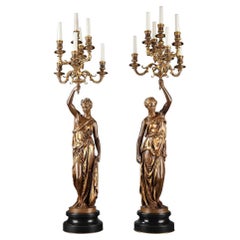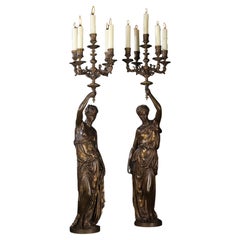Paul Dubois Lighting
3
to
2
1
3
3
3
3
Height
to
Width
to
1
2
3
3
3
3
8
1,444
1,380
1,252
1,096
Creator: Paul Dubois
Elegant Pair of Bronze Torcheres by F. Barbedienne, P. Dubois and A. Falguière
By Paul Dubois, Jean Alexandre Joseph Falguière 1, Ferdinand Barbedienne
Located in PARIS, FR
MODEL PRESENTED AT THE 1867 PARIS UNIVERSAL EXHIBITION
Listed in the Ferdinand Barbedienne’s catalogue as the “Deux femmes debout” (Two standing ladies)
Signed on each one P. Dubois – F. Barbedienne Fondeur and A. Falguière – F. Barbedienne Fondeur
Rare pair of parcel-gilt and patinated bronze figures, representing two women dressed in Antique style costume with jewels, each upholding a seven lights-arm candelabra. Standing on round bronze bases and black marble socles.
Paul Dubois (1827-1905) entered the Paris Beaux-Arts School in 1858. He exhibited at the 1865 Salon the Chanteur Florentin, illustrating Florentine sculpture, observed after his journey in Italy. This work, cast that time in silvered bronze, was exhibited at the 1867 Paris Universal Exhibition (now preserved at the Orsay museum). Dubois' success brought him many commissions, both private (Portrait of Duc d'Aumale) and public (Jeanne d'Arc, in Reims). Appointed curator at the Luxembourg museum in 1873, Dubois became also a member of the Institute and finally headmaster at the Beaux-Arts School in 1878.
Alexandre Falguière (1831-1900) studied under Jouffroy at the Paris Ecole des Beaux-Arts, began his career at the Paris Salon in 1857 and won as soon as 1859 the “Prix de Rome”. Falguière became very quickly successful and was several times awarded medals at the Salon, such in 1868 with his marble sculpture Tarcisius the Christian Boy-Martyr, or at the 1867 Paris Universal Exhibition, where he won the first medal in his category. Thanks to that success, he was immediately commissioned by private collectors as well as by the French State, whom asked him in 1878 to realize the Triomphe de la République, placed in 1881 at the summit of the Paris Arch of Triumph...
Category
1860s French Antique Paul Dubois Lighting
Materials
Bronze
Pair of Gilt and Patinated Bronze Candelabra by Ferdinand Barbedienne
By Paul Dubois, Ferdinand Barbedienne
Located in Brighton, West Sussex
A Pair of Gilt and Patinated Bronze Figural Five-Light Candelabra Cast by Barbedienne after the Models by Alexandre Falguière and Paul Dubois.
Signed ‘FALGUIERE’ and ‘P. DUBOIS’ ...
Category
19th Century French Antique Paul Dubois Lighting
Materials
Bronze
Important Pair of Monumental Parcel-Gilt and Patinated Bronze Figural Torchère
By Jean Alexandre Joseph Falguière 1, Ferdinand Barbedienne, Paul Dubois
Located in New York, NY
Mounted as lamps and cast by Ferdinand Barbedienne after models by Alexandre Falguiere and Paul Dubois. Both statues are signed on the bases.
These fine torchères are reductions ...
Category
Late 19th Century French Renaissance Antique Paul Dubois Lighting
Materials
Bronze
Related Items
Pair of French Charles X Patinated Bronze and Gilt Figurative Candelabras
Located in Dallas, TX
A fine pair of figurative candelabras in the form of a patinated bronze cherub running with a gilt torchiere in each hand. The cherubs stand on a...
Category
Early 18th Century French Charles X Antique Paul Dubois Lighting
Materials
Marble, Bronze
Matching Pair of Figural Patinated Bronze Flame Torcheres after Clodion
By Claude Michel Clodion
Located in Vancouver, British Columbia
A beautifully cast matching pair of patinated bronze figural torcheres in the manner of Clodion modeled as classically draped young girls with garlands of flowers in their hair and h...
Category
Late 19th Century French Napoleon III Antique Paul Dubois Lighting
Materials
Bronze
Pair of Silvered Bronze Large Antique Floor Lamps, Attributed to Barbedienne
By Ferdinand Barbedienne
Located in London, GB
These beautiful antique French floor lamps are cast from delicate silvered bronze, and are decorated in the refined neoclassical style. The p...
Category
19th Century French Neoclassical Antique Paul Dubois Lighting
Materials
Bronze
H 71.26 in W 13.39 in D 11.82 in
Pair of Large Patinated Bronze Figural Torcheres Cast by Barbedienne, Dated 1872
By Ferdinand Barbedienne, Émile Guillemin
Located in Brighton, West Sussex
A highly important pair of large patinated bronze figural torcheres by Émile Guillemin, cast by Ferdinand Barbedienne.
French, dated 1872.
Barbedienne Title: 'Deux Femmes, Indi...
Category
Late 19th Century French Antique Paul Dubois Lighting
Materials
Bronze
H 88.98 in W 19.69 in D 29.14 in
Pair French 19th-20th Century Neoclassical Style Iron and Parcel-Gilt Torcheres
Located in Los Angeles, CA
A Palatial Pair of French 19th/20th Century Neoclassical Revival Style Ebonized Cast-Iron and Parcel-Gilt Torcheres (torchières - Lamp Posts). The park-like torcheres surmounted with...
Category
Early 1900s French Neoclassical Revival Antique Paul Dubois Lighting
Materials
Iron, Zinc
Pair of Empire Gilt and Patinated Bronze Candelabra
Located in Essex, MA
Pair of 19th century gilt and patinated bronze candelabra now as lamps. Figural Baccantes holding torchieres. Empire or Charles X ...
Category
Early 19th Century French Empire Antique Paul Dubois Lighting
Materials
Bronze, Ormolu
Neoclassical Style Marble, Gilt and Patinated Bronze Candelabra by Barbedienne
By F. Barbedienne Foundry
Located in London, GB
The leading bronze manufactory of the French Belle Époque, Barbedienne, is responsible for the design of these exquisite candelabra. The Barbedienne foundry was established in 1838 b...
Category
19th Century French Neoclassical Antique Paul Dubois Lighting
Materials
Marble, Bronze
H 29.93 in W 11.42 in D 11.42 in
Pair of French Belle Époque 19th-20th Century Gilt Bronze and Alabaster Torchere
Located in Los Angeles, CA
A palatial pair of French Belle Époque 19th-20th century gilt bronze and alabaster tall torchières. The slender center column raised on a circular intri...
Category
Early 1900s French Belle Époque Antique Paul Dubois Lighting
Materials
Alabaster, Bronze
Pair 19th Century Japanese Imari Porcelain & Gilt-Bronze Torchere Candelabra
By Imari Porcelain
Located in Los Angeles, CA
A fine Pair of 19th century Japanese Imari Porcelain and French Gilt-Bronze Mounted Thirteen-Light Celadon Torchere Candelabra. The bottle-shaped Japonisme vases with a Royal red background, decorated with parcel-gilt and black soaring eagles in the hunt within a forestall scene. Each Vase fitted and surmounted with a French 19th century Louis XV Style 13-Light scrolled candelabrum and all raised on a circular pierced gilt-bronze plinth. circa: 1880.
Imari Porcelain (????) is the name for Japanese porcelain wares made in the town of Arita, in the former Hizen Province, northwestern Kyushu. They were exported to Europe extensively from the port of Imari, Saga, between the second half of the 17th century and the first half of the 18th century. The Japanese as well as Europeans called them Imari. In Japanese, these porcelains are also known as Arita-yaki (???). Imari or Arita porcelain has been continously produced up through the present day.
Characteristics
Though there are many types of Imari, Westerners' conception of Imari in the popular sense is associated only with a type of Imari produced and exported in large quantity in mid-17th century. This type is called Kinrande. Kinrande Imari is colored porcelain with cobalt blue underglaze and red and gold overglaze. The color combination was not seen in China at that time. Traditional Ming dynasty color porcelain used dominantly red and green, probably due to scarcity of gold in China, whereas gold was abundant in Japan in those days. The subject matter of Imari is diverse, ranging from foliage and flowers to people, scenery and abstractions. Some Imari design structures such as kraak style were adopted from China, but most designs were uniquely Japanese owing to the rich Japanese tradition of paintings and costume design. The porcelain has a gritty texture on the bases, where it is not covered by glaze. There is also blue and white Imari. Kakiemon style Imari is another type of Imari, but it tends to be categorized separately in Europe.
History
"Imari" was simply the trans-shipment port for Arita wares. It was the kilns at Arita which formed the heart of the Japanese porcelain industry.
Arita's kilns were set up in the 17th century, when kaolin was discovered in 1616 by the immigrant Korean potter, Yi Sam-pyeong (1579–1655). (He may also be known by the name, "Kanage Sambei".) Yi Sam-Pyeong, along with his extended family of 180 persons, left Korea on the offer of a privileged position in Japan. This decision was made after the occurrence of certain Japanese invasions of Korea. After Yi Sam-Pyeong's discovery, his kilns began to produce revised Korean-style blue and white porcelains, known as "Shoki-Imari".
In the mid-17th century there were also a lot of Chinese refugees in Northern Kyushu due to the turmoil on Chinese continent, and it is said one of them brought coloring technique to Arita. Thus Shoki-Imari developed into Ko-KutaniImari. Ko-Kutani was produced around 1650 for both export and domestic market. Blue and white porcelain continued to be produced and they are called Ai-Kutani. Ko-Kutani Imari for the export market usually adopted Chinese design structure such as kraak style, whereas Ai-Kutani for the domestic market were highly unique in design and are accordingly valued very much among collectors.
Ko-Kutani style evolved into Kakiemon style Imari, which was produced for about 50 years around 1700. Imari achieved its technical and aesthetic peak in Kakiemon style, and it dominated European market. Blue and white Kakiemon is called Ai-Kakiemon. Kakiemon style transformed into Kinrande in the 18th century. Kinrande used blue underglaze and red and gold overglaze, and later some other colors.
Imari began to be exported to Europe because the Chinese kilns at Ching-te-Chen were damaged in the political chaos and the new Qing dynasty government stopped trade in 1656–1684. Exports to Europe were made through the Dutch East India Company, but the designation "Imari Porcelain" in Europe connotes Arita wares of mostly Kinrande Imari.
Export of Imari to Europe stopped in mid-18th century when China began export to Europe again, since Imari was not able to compete against China due to high labor cost. By that time, however, both Imari and Kakiemon style were already so popular among Europeans, Chinese export porcelain copied both Imari and Kakiemon style, which is called Chinese Imari. At the same time, European kilns, such as Meisen also tried to copy Imari and Kakiemon.
Export of Imari surged again in late 19th century (Meiji era) when Japonism flourished in Europe. Thus in western world today, two kinds of Imari can...
Category
19th Century Japanese Japonisme Antique Paul Dubois Lighting
Materials
Ormolu, Bronze
Monumental Pair of Italian 18th Century torchère in Painted and Giltwood
Located in Atlanta, GA
A truly exquisite pair of 18th century Northern Italian torchère in painted and giltwood. The shades are pierced metal and polychromed. They are lined in a white silk.
Category
Late 18th Century Antique Paul Dubois Lighting
Materials
Wood
Pair of Pink Torchere Sconces
By Fabio Ltd.
Located in Los Angeles, CA
Italian torchere wall sconces with hand blown pink Murano glass cone shade mounted on brass frames / Made in Italy
1 light / E26 or E27 type / ma...
Category
21st Century and Contemporary Italian Mid-Century Modern Paul Dubois Lighting
Materials
Brass
Pair of 18th Century Spanish Carved Giltwood Torchère
Located in Madrid, ES
Pair of Spanish torchères in gilded wood, the base is supported by legs in the shape of a lion's claw.
Category
Mid-18th Century Spanish Baroque Antique Paul Dubois Lighting
Materials
Giltwood
Paul Dubois lighting for sale on 1stDibs.
Paul Dubois lighting are available for sale on 1stDibs. These distinctive items are frequently made of metal and are designed with extraordinary care. There are many options to choose from in our collection of Paul Dubois lighting, although gold editions of this piece are particularly popular. If you’re looking for additional options, many customers also consider lighting by and Ferdinand Barbedienne. Prices for Paul Dubois lighting can differ depending upon size, time period and other attributes — on 1stDibs, these items begin at $38,462 and can go as high as $95,000, while a piece like these, on average, fetch $80,522.



